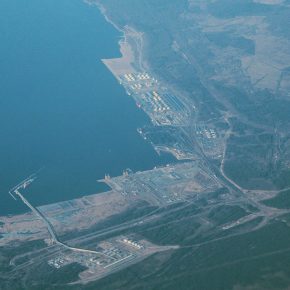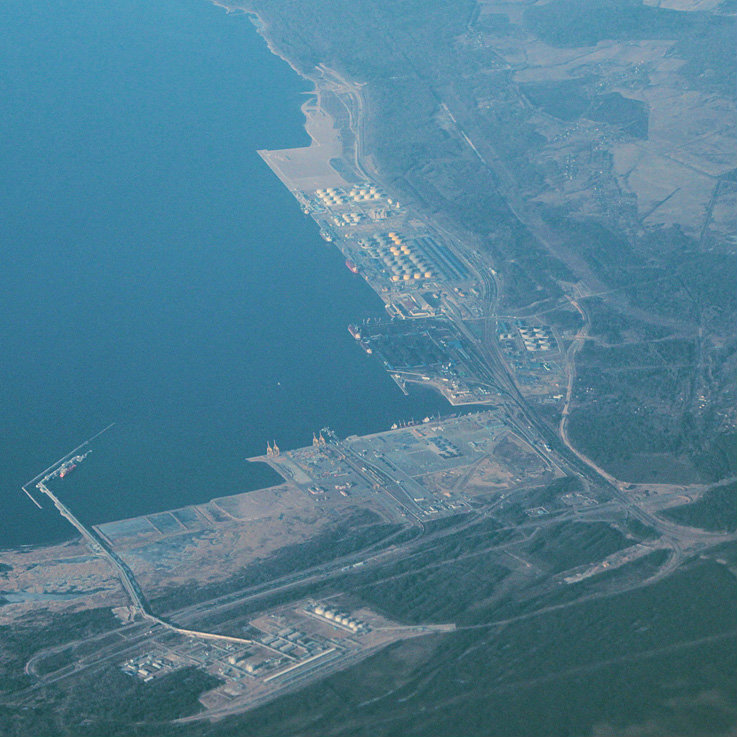
The Ust-Luga Port, Russia (Aviateur Moskva, CC BY-SA)
The 57-page document, divided into 11 sections, encompassed a large variety of social, economic, health-care and housing policies that formed the basis of Putin’s third presidency term agenda. These plans, involving a mass scale government spending, were formulated under extremely favorable economic conditions, with oil selling at around USD113 per barrel. However, only a two years later, Russia was hit by an economic crisis that soon led to the exhaustion of the state coffers. Notwithstanding Russia’s new economic situation, the old plan for Russia’s socioeconomic development remained in place. This meant that the responsibility for carrying out the orders was basically delegated to regional governors without providing them with the means to do so.
For example, the executive order number 597 on the social policy states that, by 2018, the average wage of social workers across Russia has to match the average wage in their respective regions. For doctors, university professors and scientific workers, the target was set much higher – 200 per cent of the average wage in their respective region. Moreover, among other measures, was a promise to create 25 million high-skilled jobs and give workers more decision making powers in both state and private enterprises.
In December 2017, during his annual press conference in Moscow, Mr. Putin proclaimed that 90 per cent of the targets stipulated in the May Decrees had been met. “Hadn’t we set these goals for wage raises for social workers, the situation would have been worse, so it was the right decision,” he said.
However, just a couple of months before the conference, at the meeting of the State Council, All-Russia People’s Front’s head of executive committee, Alexei Anisimov, was much more cautious. “We have inspected 179 of your executive orders in the framework of the May Decrees implementation monitoring. Out of those 179 orders, we have found 35 to be fully implemented, 44 not implemented and 100 have been implemented only partially and need to be finalized,” Anisimov was quoted by Medusa.
Regional disparities aggravated
The economic situation in some regions have only worsened. The insistence of the Russian central government on implementing these orders in spite of the lack of federal funding has left regional governors to their own devices. As a consequence, Moscow’s inflexibility seems to have created further economic disparities among the already extremely economically unequal Russian regions.
Some Russian regions, rich in natural resources or well situated for international trade, like Saint Petersburg, have embraced these reforms. The Leningrad region governor has used the federal policies as an incentive to further develop the already well-performing regional economy. A new export strategy of Leningrad region is designed to dramatically increase the amount of exports, up to 190 per cent by 2025.
To achieve this goal, a large warehouse logistics center will be built near the port of Ust-Luga, 68 miles west of Saint Petersburg, along with a terminal for transshipment of mineral fertilizers, an airport and a new cargo air terminal in the port. The region in northwestern part of Russia is already one of the main Russian exporters of goods and services, with annual exports worth approximately USD5bn. The Leningrad region is also one of the best performers among Russian regions in terms of debt to revenue ratio, with a mere 4,7 per cent as of October 2017.
However, most Russian regions have neither the quality of infrastructure nor the favorable geographical location that the Leningrad region has. Opportunities to engage in foreign trade are scarce and one of the main sources of income comes from the federal funding. After the 2014 crisis, when the state coffers became quickly depleted, many Russian regional governors found themselves under an increasing pressure. The targets for social and economic development were still in place, but the funding from Moscow needed to meet them was not coming.
Many governors turned to credit institutions for help. According to the Russian Ministry of Finance, the aggregate debt of all Russian regions went up by 28,6 per cent in 2013, 20 per cent in 2014 and 11 per cent in 2015. In 2017, 8 Russian regions’ debt-to-revenue ratio was above 100 per cent, with Mordovia’s 194,2 per cent topping the list. Mordovia’s indebtedness might be exceptionally high, but the problem is widespread – 23 Russian regions’ debt-to-revenue ratio was above 80 per cent in 2017. The most burdened regions are Mordova, Kostromsk, Khakasia, Karelia, Smolenks, Pskov and the Kardino-Balkar republic. The corresponding numbers for the capital city Moscow and Saint Petersburg were 2,4 per cent and 1,6 per cent, respectively.
The simple fact is that a great number of Russian regions simply can’t afford the cost associated with the reforms. The Republic of Kalmykia’s GDP in 2015 stood at around RUB47bn. According to the Federal Service of State Statistics, there are 3,475 doctors in Kalmykia with an average salary of RUB45,000. To meet Moscow-set-targets, the local government has to spend RUB52m, or more than 1 per cent of its GDP. The same would then apply to university professors, assistant teachers, researchers and all social workers.
Easy fix
As the final date for the implementation of some of Putin’s executive orders approached, many regional governors across Russia started boosting about their achievements. In the Krasnodar region, during a meeting of the Legislative Assembly in late January 2018, representatives from the Ministry of Healthcare discussed with local MP’s the implementation of Mr. Putin’s orders in their region.
“Looking at the numbers from the Q4’17, I can say that the program has been nearly concluded. Doctor’s wages have reached 187 per cent of the average regional wage, and senior and junior medical personal’s wages reached 96,8 per cent and 81 per cent, respectively. Those are averages calculated from data we received from 140 medical institutions in our region,” Krasnodar’s healthcare minister, Vadim Janin said during the meeting according to SMnews.
Janin then added that program will be fully concluded at the beginning of 2018. The cost will be a bit over RUB2bn. “A second budget revision will be needed,” he said.
The timely implementation of Mr. Putin’s orders seems to have become a matter of prestige for many regional governors. According to the rating put together by Medialogia, the Ryazan region, just a couple of miles southeast of Moscow, ranked as the second best region in implementing the May Decrees in 2017.
Earlier this year, the Ryazan information agency quoted the regional governor, Nikolai Lyubimov, saying that “the implementation of the May Decrees is the key goal of his administration and that it will improve the quality of life in the region.” In November 2017, Lyubimov explained to the heads of regional ministries that they will be held personally accountable for not implementing the orders in time.
The top down approach created enough pressure to ultimately help meet the targets. However, soon it became obvious that many hospitals, forced to raise wages without the means to do so, solved the problem by simply cutting the working hours by half. Many doctors suddenly became part-time employees with the same responsibilities and the same pay.
From a short-term perspective, this might not be that big of an issue for Moscow. What matters is that the orders are implemented, at least on paper, and the results can be presented to Russian voters before the upcoming elections. However, for the regions, the problem runs deep. Many of them became heavily indebted without significantly improving their socioeconomic states. Now they will become even more dependent on the federal funding. With the current state of Russian economy, that relationship could be sustained. The question is for how long.
Filip Brokeš is an analyst and a journalist specializing in international relations.


